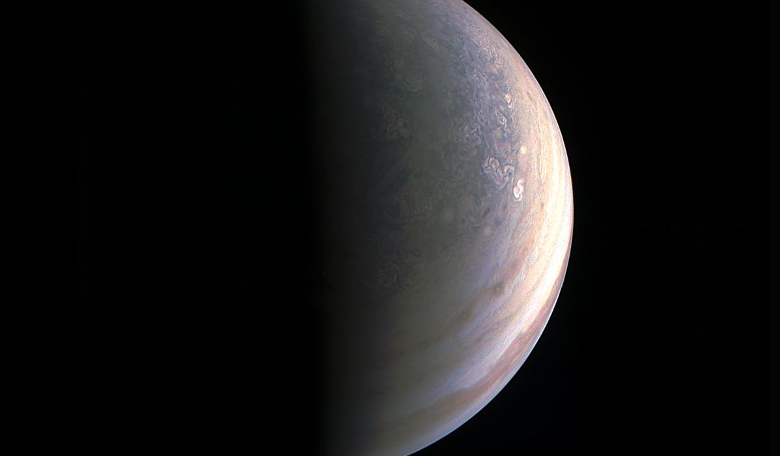The first images of Jupiter’s north pole and southern aurora have been received from NASA’s Juno spacecraft and, perhaps as expected, the images tell a story of weather activity and storm systems not seen on any other gas giant in the Solar System.
The close flyby of the north and south poles was successfully conducted on 27th August, when Juno cruised 4,200 kilometres (2,500 miles) above Jupiter's swirling clouds. "First glimpse of Jupiter's north pole, and it looks like nothing we have seen or imagined before," said Scott Bolton, principal investigator of Juno from the Southwest Research Institute in San Antonio. "It's bluer in colour up there than other parts of the planet, and there are a lot of storms. There is no sign of the latitudinal bands or zone and belts that we are used to – this image is hardly recognisable as Jupiter. We're seeing signs that the clouds have shadows, possibly indicating that the clouds are at a higher altitude than other features."
Although the analysis of this first data collection will take some time to be released, these unique discoveries have already highlighted Jupiters distinctiveness and the differences do not stop there. "Saturn has a hexagon at the north pole," said Bolton. "There is nothing on Jupiter that anywhere near resembles that. The largest planet in our solar system is truly unique. We have 36 more flybys to study just how unique it really is."
JunoCam was not the only instrument busy working away, as the spacecraft’s Jovian Infrared Auroral Mapper (JI-RAM), supplied by the Italian Space Agency, has also sent back an unprecedented view of Jupiter’s southern aurora captured in infrared at wavelengths ranging from 3.3 to 3.6 microns (see below).
 Infrared image giving an unprecedented view of Jupiter's souther aurora, as captured by NASA's Juno spacecraft on August 27, 2016. Image: NASA/JPL-Caltech/SwRI/ASI/INAF/JIRAM
Infrared image giving an unprecedented view of Jupiter's souther aurora, as captured by NASA's Juno spacecraft on August 27, 2016. Image: NASA/JPL-Caltech/SwRI/ASI/INAF/JIRAM
Due to Earth’s position in respect to Jupiter's south pole, the gas giant’s southern aurora can hardly be seen, therefore Juno's unique polar orbit gives scientists the first opportunity to observe this region in detail.
"JIRAM is getting under Jupiter's skin, giving us our first infrared close-ups of the planet," said Alberto Adriani, JIRAM co-investigator from Istituto di Astrofisica e Planetologia Spaziali, Rome. "These first infrared views of Jupiter's north and south poles are revealing warm and hot spots that have never been seen before. And while we knew that the first ever infrared views of Jupiter's south pole could reveal the planet's southern aurora, we were amazed to see it for the first time. No other instruments, both from Earth or space, have been able to see the southern aurora. Now, with JIRAM, we see that it appears to be very bright and well structured. The high level of detail in the images will tell us more about the aurora's morphology and dynamics."
And if this first wave of images isn’t enough to satisfy curious observers, then you can also listen to Jupiter too, or rather listen to its radio emissions. The radio/plasma wave experiment (Waves) was also fired up to record ghostly-sounding transmissions emanating from above the planet – a phenomena that has been known about since the 1950s but has never been studied from such proximity.
"Jupiter is talking to us in a way only gas-giant worlds can," said Bill Kurth, co-investigator for the Waves instrument from the University of Iowa, Iowa City. "Waves detected the signature emissions of the energetic particles that generate the massive auroras which encircle Jupiter's north pole. These emissions are the strongest in the solar system. Now we are going to try to figure out where the electrons come from that are generating them."
To listen to Jupiter’s auroras, click here https://www.youtube.com/watch?v=slE2i0O0pDY











